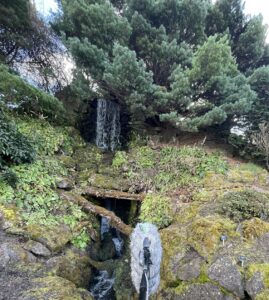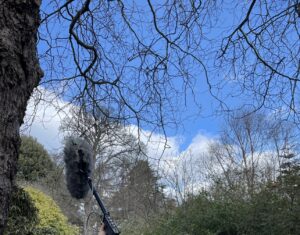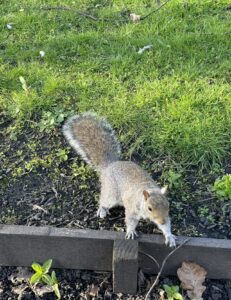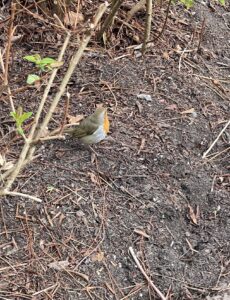Preparations for game audio:
Game audio style:
After discussions and communication, we have decided to follow a realistic sound environment and incorporate more natural sounds in our game audio design. We will add some music effects on this basis to enhance the game atmosphere, enrich the sound environment, and increase player immersion.
Recording section:
After our meeting to determine the direction of game audio design and the needs for sound materials, I decided to record some sounds on-site to enrich our sound library materials.
I have booked the equipment:
Sound Devices – MixPre-6 II
Sennheiser MKH 416 short shotgun microphone
Rycote – Windshield/Jammer
Rode 3m Boompole
AAA Rechargeable batteries X4
SD Card -16GB
Beyerdynamic – DT 770 PRO 250 OHMS
XLR Male to XLR Female
I selected the Royal Botanic Garden Edinburgh as the location for recording because it provides us with rich environmental materials and a quiet space atmosphere. The microphone used is the Sennheiser MKH 416, which has strong directional capability, allowing for better and clearer reception of on-site sound. The recording location was selected in the deep part of the botanical garden to effectively reduce noise pollution. I recorded ambient sounds and animal calls, such as bird calls, river sounds, squirrel running sounds, and wind sounds. After finishing, I imported them into Logic for editing and eventually created sound effects for the game.




Foley section:
When editing the recorded audio, we searched and selected usable audio files. We then compared the available materials with the required sound list and created a list of sounds that needed to be synthesized. We then had to use our imagination and common everyday objects to synthesize the missing sounds on the list.
Prepared materials:
Dry leaves, fresh leaves, withered yellow roses, water cup, effervescent tablet, plastic tube, rice, cardboard box, electric toothbrush, bubble wrap, celery, aluminum foil, corn flakes, plastic container, jacket.
After everything was prepared, we booked Music Studio 5 – B12 and reserved the use of the following equipment:
AKG C414B Multi pattern large diaphragm condenser
Beyerdynamic – M 201 – Dynamic – Hypercardiod
Microphone Stand
XLR Male to XLR Female
We booked two types of microphones for our recording session, one is a dynamic microphone and the other is a condenser microphone. The sound recorded by the dynamic microphone is rich, full, and has strong noise resistance, while the condenser microphone has high clarity and sensitivity. Each type of microphone has its own unique characteristics and advantages in picking up sound, providing us with more options during foley recording.
We foleyed many sounds, such as:
Birds flying: To simulate the sound of birds flapping their wings, we used clothes and tissues to flap quickly. Thin clothes and soft paper were used to simulate the sound of small birds flying, while jackets and slow, sweeping motions were used to simulate the sound of large birds flying.
Rain: To simulate the sound of rain, we each held a handful of rice and scattered it onto cardboard on the ground from a height. The frequency of the rice scattering was controlled to simulate different rainfall intensities. Then, we used corn chips held in our hands to simulate the high-pitched and hard-sounding raindrops, representing different states of rainfall.
Animals stepping on leaves: We crushed dry and fresh leaves with our hands to simulate the sound of small animals stepping on leaves. Finally, we placed the leaves on the ground and used our feet to simulate the sound of large animals stepping on leaves.
Bees flying: We put an electric toothbrush in a sealed bag, pressed the switch, and adjusted the angle to simulate the sound of bees flying.
Burning branches: We squeezed plastic foam to simulate the sound of burning branches.
After finishing the recording, I edited and modified the sound recorded from the dynamic microphone, and then organized it before uploading it to the group’s shared document for later production use.
Music section:
I created music for the third part of the game, rebirth part. This section depicts the aftermath of a raging fire where the screen is predominantly black, and players can see twisted tree roots when looking down. At this point, the protagonist is on the verge of death, and the Mother Tree seeks to transfer energy to other trees with its last bit of strength. The white balls appearing on the tree roots represent the energy transfer process.
This section is sad but also symbolizes new hope. In designing the music, I opted for a soothing melody with a foundation of quarter and eighth notes. I chose a lower pitch to give the music a slow and somber feel that conveys the dying life of the Mother Tree. I then added crisp high-frequency notes of wind chimes to illustrate the Mother Tree’s energy transfer to other fresh life in the scene. The music is vibrant and rhythmic, presenting a combination of a somber main melody and lively notes that depict the cycle of life and death. The constant transfer of energy reflects the endless cycle of the biosphere, conveying the greatness of life and the belief that it never truly fades.
When combined with the visuals, the music enables players to perceive the movement of energy visually. The collision of ethereal and deep sounds enhances the player’s immersion and amplifies the impact of the game’s overall experience.
Sound design:
The player spawns in a terrain surrounded by rocks with gentle and soothing music playing in the background. As the player controls the controller, they gradually ascend and can see animals such as foxes and birds, as well as the dense forest around them, from a subjective point of view. Birds fly around the forest, and the sound of flapping wings helps the player locate them at any time. As the player rises, the environmental sounds also become richer. Upon reaching the highest point, the weather changes to rain. The rain is designed to be immersive with dense and surround sound effects. The second part of the sound design begins with the appearance of fire, where the sound of flames feels close to the player and adds to the immersive experience. The life of the trees gradually weakens, and the music changes to a mournful melody that complements the desolate atmosphere. In the third part, when the trees burn out, the player’s view turns dark, and they can see the chaotic roots of the trees beneath them. As the center of white energy, the Mother Tree is using its last strength to spread energy to the surrounding trees and make its final contribution to this homeland. The music uses slow and mournful long notes as the foundation, and adds crisp wind chimes to express the collision between the decline of life and the vitality of new life, while also embodying hope for new life in the midst of a desolate and sorrowful atmosphere. At the end of the game, the player is reborn in the forest, surrounded by a lively and vibrant environment. The music uses piano and cello to create a soothing and vibrant melody, expressing the theme of the greatness of life and the belief that it never truly fades away.
Regarding personal work reflection:
Firstly, if I can better allocate my time, I will have more time to record more sound materials and enrich the sound library of the team, which can provide more sound options in the later stage and more randomly played sound materials in Wwise. Secondly, the sound design of the project can be more diverse, and more interactive sounds can be added in c#. This means that there is still a lot of learning space for these directions in the future.
Regarding Collaboration:
Being able to participate in every step of the sound production process allowed me to have a more comprehensive understanding of game sound design. After each visual adjustment, the sound would follow a new direction, allowing us to explore sound design that is better suited to the visual design. This is an essential part of sound work and a necessary element in team development.

